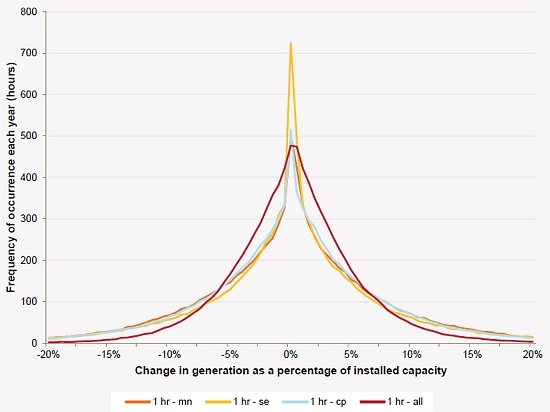Baseload vs wind - the debate ramps up
In the piece I wrote earlier this week, Baseload vs Wind – a dumb argument, I outlined that while wind power experiences significant variance in output, within very short periods of time (five minutes) the loss of output is potentially less of an issue than the sudden unplanned breakdown of a conventional baseload power plant.
A reader pointed out that while wind power rarely varied by more than 5 per cent of capacity within a five minute period, looking at the AEMO data I had referenced, it varied by a far larger amount within the period of an hour. Therefore he suggested I had not told the complete truth.
In reality it is not really material to the argument. That’s because although power stations have a lot of difficulty ramping up to replace a large amount of lost capacity within five minutes, within an hour the amount of capacity that can be ramped up is very large, as I’ll explain.
The data I had omitted is charted below, showing that within an hourly period, output from the aggregate of all South Australian wind farms can vary by far more than 5 per cent of installed capacity (although the majority of the time it is still less than 5 per cent and less than 10 per cent about 90 per cent of the time).
The extent of hourly change in South Australian wind power output

Source: AEMO (2012) South Australian Wind Study Report 2012
This is not such a problem for reliability provided other power stations have the ability to ramp-up to replace any reduction in output.
As you’d see in my prior article, while prices spiked to extreme levels for the first half hour after the Millmerran coal power station tripped off, they recovered quite quickly. In the period preceding the Millmerran trip, prices in QLD were $58 per megawatt-hour. Then they spiked up to an average over $2000 during the initial 30 minutes of the trip, before falling to $92 in the next half hour and then $68 after that. So within an hour of Milmerran tripping off, prices were back to similar levels as had occurred before the trip.
AEMO actually publishes a listing of how much each power station in the NEM can be ramped up within an hour. All hydro capacity in the NEM can be ramped up to full capacity within an hour, in fact within substantially less than an hour. This provides around 8000MW of incredibly responsive generation. In addition pretty much all gas generators bar South Australia’s Torrens A and B power stations can be ramped up to full capacity within an hour.
What might surprise many is that even a number of coal generators can ramp-up (and down) a very substantial amount of capacity within an hour, provided they’re already online. While old coal generators have difficulty with ramping up and down, for example Hazelwood's ramp rate is only 120MW, the newer generators in Queensland of Gladstone, Callide, Tarong and Tarong North have ramp rates above 600MW per hour as does NSW’s Bayswater and Eraring, and Victoria’s Loy Yang A and B.
Now many of these generators won’t have that kind of capacity spare. But if wind were to grow to large amounts such that it would curtail the output of these coal generators, then they can ramp back up as wind drops-off, supplementing the several thousand megawatts available from hydro and gas.
There are some other factors that can complicate the extent to which capacity can be ramped-up and down to cope with wind, all of which have been examined by AEMO. Nonetheless, the end conclusion is that we could increase the amount of wind in the NEM by several thousand megawatts without putting the electricity supply reliability at risk.
















